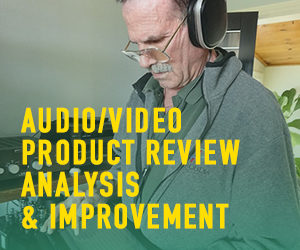In reading hi-fi equipment reviews in various magazines, I have been struck at the words the writers use to describe the sound quality.
Here is a sampling:
“Sheen, Subtle Woven Texture, Foundation, Invariably Musical, Breathy, Liquidity, Tension, Natural Rawness, Ripe, Incisive, Rhythmic Drive, Essential Nature, Tangible, Atmospheric, Textural Resolution, Bluster, Out-of-The-Head Soundstage, Focus, Tonal Accuracy, Poise, Warm Sweetness, Harmonic Rightness, Sophistication, Bloom, Grown-Up, Authoritative, Fruity, Confidence, Enthusiasm, Depth Perspective, Soporific, Space, Bloat, Transparency, Immediate, Timing, Lyrical, Ease, Timbral Realism, Tonally Refined, Bracing, Sonic Perspective, Dimensionality, Weight, Impact, Unimpeded Flow, Seamlessness, Immediacy, Air, Heft”
What do these words mean in terms of audio? Well, I don’t know. They are journalistic fluff that do not really have a meaning in audio. There is no problem in using these words per se. But, some basic terms that do have audio meaning should also be included.
Audio can be broken down into three basic words: Clarity, Detail, and Dynamics.
Clarity means how identifiable the instruments are, and this is a reflection of harmonic distortion. The more harmonic distortion there is, the less “Clear” the instruments are. You would have difficulty in distinguishing a violin from a viola, a trumpet from a cornet, a tenor saxophone from an alto saxophone, a flute from a piccolo, a trombone from a baritone. Also, if the music is complex, such as a full orchestra, it would sound congested. On the other hand, if the harmonic distortion is primarily even-ordered (2nd, 4th, etc.), and there is not too much of it (less than 2%), it would sound like there is more substance to the music and can be euphonic (sounds pleasant). This is a characteristic of triode tube amplifiers. So, the amount of harmonic distortion has to be tempered with the type of harmonic distortion.
Detail is a reflection of how much noise there is, which is affected by such things as how many output devices there are (the more output devices, the lower the noise), the quality of the phono preamplifier when using a low-output phono cartridge, the compliance of the phono cartridge, the type of tubes, the mass of the cones in the midrange speaker driver and the tweeter.
Dynamics is a feature of the recording (dynamics are compressed somewhat on vinyl), the amount of capacitance in the power supply, whether using 120 volts or 240 volts wall AC power. A large number of output devices can increase the transient dynamics.
So, I suggest that as journalists, we describe these basic characteristics in our audio equipment reviews, and include the fluff if we wish, just for continuity with previous articles.

